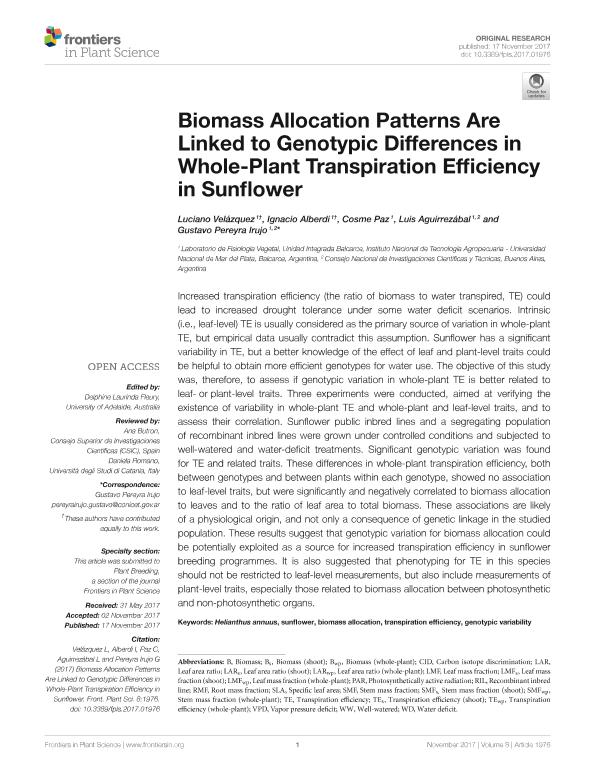Mostrar el registro sencillo del ítem
dc.contributor.author
Velazquez, Luciano

dc.contributor.author
Alberdi, Ignacio

dc.contributor.author
Paz, Cosme Daniel

dc.contributor.author
Aguirrezábal, Luis Adolfo Nazareno

dc.contributor.author
Pereyra Irujo, Gustavo Adrian

dc.date.available
2019-02-19T18:19:30Z
dc.date.issued
2017-11
dc.identifier.citation
Velazquez, Luciano; Alberdi, Ignacio; Paz, Cosme Daniel; Aguirrezábal, Luis Adolfo Nazareno; Pereyra Irujo, Gustavo Adrian; Biomass allocation patterns are linked to genotypic differences in whole-plant transpiration efficiency in sunflower; Frontiers in Bioscience; Frontiers in Plant Science; 8; 11-2017; 1-12
dc.identifier.uri
http://hdl.handle.net/11336/70468
dc.description.abstract
Increased transpiration efficiency (the ratio of biomass to water transpired, TE) could lead to increased drought tolerance under some water deficit scenarios. Intrinsic (i.e., leaf-level) TE is usually considered as the primary source of variation in whole-plant TE, but empirical data usually contradict this assumption. Sunflower has a significant variability in TE, but a better knowledge of the effect of leaf and plant-level traits could be helpful to obtain more efficient genotypes for water use. The objective of this study was, therefore, to assess if genotypic variation in whole-plant TE is better related to leaf- or plant-level traits. Three experiments were conducted, aimed at verifying the existence of variability in whole-plant TE and whole-plant and leaf-level traits, and to assess their correlation. Sunflower public inbred lines and a segregating population of recombinant inbred lines were grown under controlled conditions and subjected to well-watered and water-deficit treatments. Significant genotypic variation was found for TE and related traits. These differences in whole-plant transpiration efficiency, both between genotypes and between plants within each genotype, showed no association to leaf-level traits, but were significantly and negatively correlated to biomass allocation to leaves and to the ratio of leaf area to total biomass. These associations are likely of a physiological origin, and not only a consequence of genetic linkage in the studied population. These results suggest that genotypic variation for biomass allocation could be potentially exploited as a source for increased transpiration efficiency in sunflower breeding programmes. It is also suggested that phenotyping for TE in this species should not be restricted to leaf-level measurements, but also include measurements of plant-level traits, especially those related to biomass allocation between photosynthetic and non-photosynthetic organs.
dc.format
application/pdf
dc.language.iso
eng
dc.publisher
Frontiers in Bioscience

dc.rights
info:eu-repo/semantics/openAccess
dc.rights.uri
https://creativecommons.org/licenses/by/2.5/ar/
dc.subject
Biomass Allocation
dc.subject
Genotypic Variability
dc.subject
Helianthus Annuus
dc.subject
Sunflower
dc.subject
Transpiration Efficiency
dc.subject.classification
Agricultura

dc.subject.classification
Agricultura, Silvicultura y Pesca

dc.subject.classification
CIENCIAS AGRÍCOLAS

dc.title
Biomass allocation patterns are linked to genotypic differences in whole-plant transpiration efficiency in sunflower
dc.type
info:eu-repo/semantics/article
dc.type
info:ar-repo/semantics/artículo
dc.type
info:eu-repo/semantics/publishedVersion
dc.date.updated
2019-02-12T16:58:23Z
dc.identifier.eissn
1664-462X
dc.journal.volume
8
dc.journal.pagination
1-12
dc.journal.pais
Suiza

dc.journal.ciudad
Lausana
dc.description.fil
Fil: Velazquez, Luciano. Consejo Nacional de Investigaciones Científicas y Técnicas; Argentina. Universidad Nacional de Mar del Plata; Argentina. Instituto Nacional de Tecnología Agropecuaria. Centro Regional Buenos Aires Sur. Estación Experimental Agropecuaria Balcarce; Argentina
dc.description.fil
Fil: Alberdi, Ignacio. Consejo Nacional de Investigaciones Científicas y Técnicas; Argentina. Universidad Nacional de Mar del Plata; Argentina. Instituto Nacional de Tecnología Agropecuaria. Centro Regional Buenos Aires Sur. Estación Experimental Agropecuaria Balcarce; Argentina
dc.description.fil
Fil: Paz, Cosme Daniel. Consejo Nacional de Investigaciones Científicas y Técnicas. Centro Científico Tecnológico Conicet - Mar del Plata; Argentina. Universidad Nacional de Mar del Plata; Argentina. Instituto Nacional de Tecnología Agropecuaria. Centro Regional Buenos Aires Sur. Estación Experimental Agropecuaria Balcarce; Argentina
dc.description.fil
Fil: Aguirrezábal, Luis Adolfo Nazareno. Consejo Nacional de Investigaciones Científicas y Técnicas. Centro Científico Tecnológico Conicet - Mar del Plata; Argentina. Universidad Nacional de Mar del Plata; Argentina. Instituto Nacional de Tecnología Agropecuaria. Centro Regional Buenos Aires Sur. Estación Experimental Agropecuaria Balcarce; Argentina
dc.description.fil
Fil: Pereyra Irujo, Gustavo Adrian. Consejo Nacional de Investigaciones Científicas y Técnicas. Centro Científico Tecnológico Conicet - Mar del Plata; Argentina. Universidad Nacional de Mar del Plata; Argentina. Instituto Nacional de Tecnología Agropecuaria. Centro Regional Buenos Aires Sur. Estación Experimental Agropecuaria Balcarce; Argentina
dc.journal.title
Frontiers in Plant Science
dc.relation.alternativeid
info:eu-repo/semantics/altIdentifier/url/http://journal.frontiersin.org/article/10.3389/fpls.2017.01976/full
dc.relation.alternativeid
info:eu-repo/semantics/altIdentifier/doi/https://doi.org/10.3389/fpls.2017.01976
Archivos asociados
